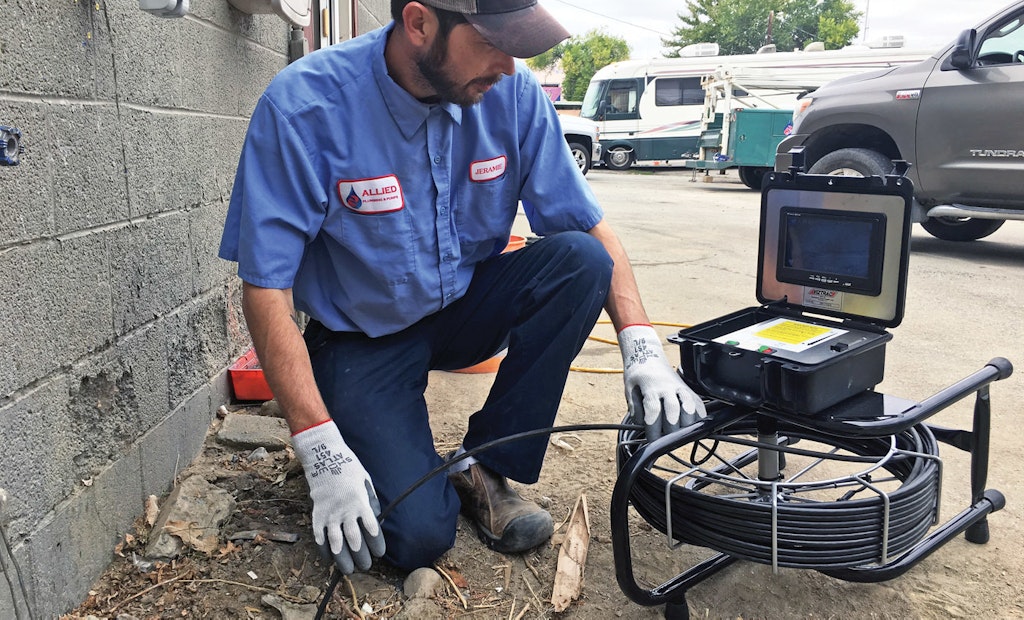
Jeramie Chisum of Washington-based Allied Plumbing and Pumps feeds a Viztrac inspection camera from Amazing Machinery into a lateral line cleanout.
An old adage says that, generally speaking, you get what you pay for. But as Ron Smiley discovered, it’s also possible to flip that saying on its ear — get good value and improve customer service — by paying less, not more.
As evidence, Smiley — the owner of Allied Plumbing and Pumps, based in Wenatchee, Washington — points to Viztrac pipeline inspection camera systems made by Amazing Machinery. The company owns several of the cameras, which come in three good-better-best models called the Basic, Pro and Max. Standard features on each model include a 3/8-inch-diameter push cable, a color LED monitor, a cable reel and stand, a stainless steel camera body with a sapphire lens, a 1 3/8-inch-diameter waterproof camera head, six LED lights with a dimmer, and a vision angle of 60 degrees.
What really appealed to Smiley, however, was the cameras’ price points, which start at $1,495 for the Basic and range up to $2,395 for the Max. It’s not that Smiley doesn’t invest in expensive equipment; the company owns a wide array of more expensive cameras made by Spartan Tool, Envirosight, RIDGID and Aries Industries that are used in conjunction with various services the company provides, such as cleaning municipal sewer lines, pipe bursting and CIPP lining.
But for simpler applications, like inspections of clogged residential lateral lines, the Viztracs offer a great blend of performance and customer service. Moreover, because they’re so relatively inexpensive, Smiley says he doesn’t need to charge residential customers extra for inspections related to clogs, which helps him be more competitive pricewise. (He still charges for things such as looking at laterals for home presale inspections.)
“The main benefit is that we can cost-effectively put one of these cameras in our trucks and get an immediate return (on investment) from them,” explains Smiley, a fourth-generation plumber. “Because they’re relatively inexpensive cameras, we don’t need to charge more to cover that investment. It’s a lot harder to do that on a piece of equipment that costs $10,000.
“They basically changed our business model in the sense that before, we looked at inspections as an opportunity to upsell services. Now, we’re able to look at them more as adding value. And I see a higher return on the added-value business model compared to the upsell business model.”
How does that work? In a nutshell, inspections often reveal problems — cracked and structurally compromised pipelines for example — that result in bigger and more profitable jobs, such as pipe relining or pipe bursting. “The costs of jobs like those can range from $1,000 for a point repair to $20,000 for a pipe replacement (lining),” he says.
The cameras bring another benefit to the table: They protect the company from service callbacks. Essentially, if a camera inspection reveals a problem such as roots penetrating cracks in a pipe and the customer only wants to pay for unclogging the drain instead of opting for a long-term solution to the problem, Smiley won’t warranty his work. As such, customers who decline to fix the problem have to pay for service callbacks.
“It puts the liability on the customer because they choose the level of service they want,” he notes. “If they want to do just a simple in and out, we tell them ‘You’re the customer — you’re the boss.’ They take the risk.”
Furthermore, the cost of the Viztracs is often less than a repair for one of Smiley’s more expensive cameras. If a Viztrac breaks down, which is bound to happen sooner or later because technicians are hard on equipment and the cameras are subject to harsh working conditions, it’s not as big a setback as when a much pricier camera breaks down, he says. In addition, the camera systems are easy to transport; the weight ranges from about 48 pounds for the Basic model up to approximately 65 pounds for the Max.
Smiley got a good look at a Viztrac camera at the Water & Wastewater Equipment, Treatment & Transport (WWETT) Show two years ago. “We had been bouncing around between various manufacturers, trying to find the right combination of customer service and durability — and the right price point,” he explains. “We tried the Viztracs out at the WWETT Show and bought two units. We had great success and started ordering more of them. We can buy four of them for the price we were paying for other cameras.”
Of course, more expensive cameras offer higher-level bells and whistles, such as better high-definition monitors and self-leveling cameras. But, Smiley says the Viztracs are more than adequate in the area that counts most: showing customers what’s going on with their pipelines. “A picture is worth a thousand words,” he says, noting how actually seeing a problem helps customers feel comfortable with a diagnosis as opposed to feeling suspicious they’re being scammed for a very expensive and possibly unnecessary repair.
“They’re a great selling tool for us,” adds Smiley, who runs eight service vehicles and serves the north-central region of Washington. He also relies on Spartan Tool cart-mounted jetters, a Spartan Tool Warrior trailer jetter, a hot-water jetter built by Jetters Northwest, pipe bursting systems made by Hammerhead Trenchless and RODDIE, and horizontal directional drilling machines made by RODDIE.
“We have nicer cameras with more features that do a wider range of inspections,” he concludes. “But for the average residential lateral line, the Viztracs are great. We get a lot more for less.”





